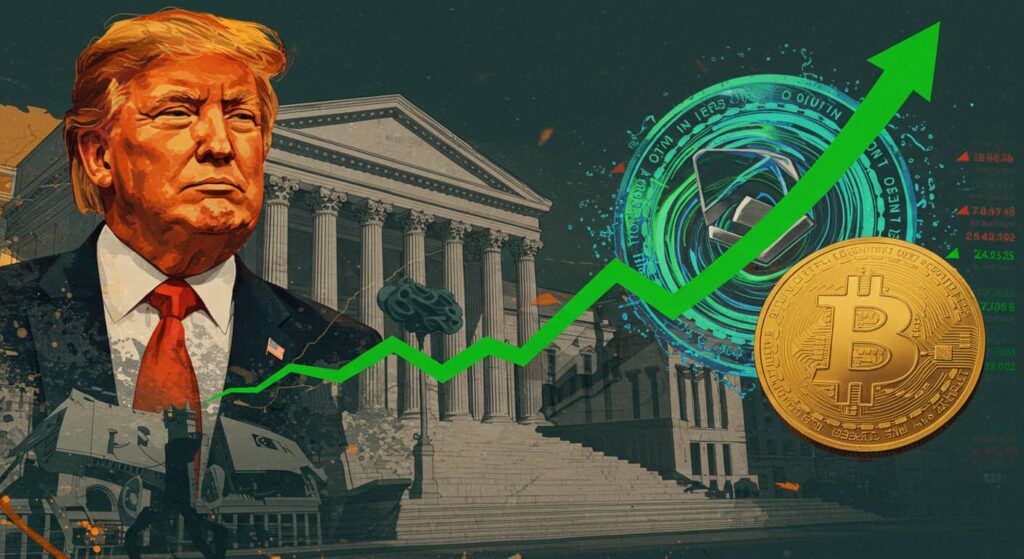In a year already defined by intensifying scrutiny of digital assets, the Trump-linked stablecoin USD1 has emerged not only as a financial instrument of growing consequence, but also as a catalyst for broader shifts in the architecture of global crypto markets. Against the backdrop of a $2 billion deal involving UAE-backed MGX and crypto exchange Binance, USD1 has quietly transitioned from an obscure token to a vessel of monetary power—intertwining geopolitics, digital finance, and presidential privilege in a single maneuver.
The immediate aftermath of the deal can’t be ignored. This mammoth $2 billion investment into Binance has had a notable impact on the cryptocurrency market, particularly on Binance’s native token, BNB. Following the announcement, BNB’s price surged by approximately 15% over two days, rising from around $507 to over $580. This surge reflects increased investor confidence and heightened trading activity, with BNB’s trading volume and open interest experiencing significant upticks.
The investment also had a ripple effect on the broader crypto market. Bitcoin (BTC) saw a modest increase of about 2%, while Ethereum (ETH) experienced a 3% rise in the immediate aftermath. These movements suggest that substantial institutional investments can bolster market sentiment across various digital assets.
It’s important to note that while such investments can stimulate short-term market enthusiasm, the long-term implications depend on broader economic factors and regulatory developments. As the crypto industry continues to evolve, institutional participation like MGX’s investment in Binance underscores the growing intersection between traditional finance and digital assets.
The Ascendancy of Stablecoins in a Shifting Monetary Order
Stablecoins have long promised to bring predictability to the famously volatile world of crypto assets. Pegged to fiat currencies and backed by reserves—typically short-term U.S. treasuries and cash equivalents—they offer the liquidity and utility of cryptocurrencies without the rollercoaster valuations. But until recently, their role has been largely confined to crypto-native contexts: exchanges, DeFi protocols, and speculative arbitrage.
USD1’s use as the settlement currency in MGX’s $2 billion acquisition of a Binance stake signifies something more fundamental. For the first time, a state-backed institutional investor is transacting at scale using a private stablecoin not issued by a legacy financial institution, but by a venture intertwined with the family of a sitting U.S. president. This marks a potential turning point—not merely for stablecoins, but for the credibility of blockchain-native finance as an alternative financial system.
The stablecoin model profits from scale. With interest rates on U.S. Treasuries hovering around 4–5%, a $2 billion reserve pool can yield annual returns in excess of $80 million. As such, the success of USD1 is not just symbolic. It is financially transformative for World Liberty Financial (WLFI), the issuing entity in which the Trump family reportedly holds a majority stake.
But the real signal lies in what this transaction suggests: a migration of institutional capital from the traditional banking sector toward decentralized finance rails, facilitated not through public-private partnerships, but through privately issued, politically entangled instruments.
Legal Grey Zones and the Ethics of Presidential Profit
The promise of stablecoins is stability; the peril lies in opacity. In the case of USD1, concerns abound that the coin’s architecture—backed ostensibly by U.S. sovereign debt and pitched as “the most transparent stablecoin in the world”—is being deployed in service of influence rather than innovation.
That a sitting president’s family stands to profit directly from a financial instrument now at the center of multibillion-dollar foreign investment deals raises profound ethical and constitutional questions. Critics argue that USD1 is not merely a stablecoin—it is a conduit for transnational influence.
The optics are further complicated by the coin’s integration with TRON, a blockchain ecosystem founded by Justin Sun, who faces unresolved legal disputes with the U.S. Securities and Exchange Commission. Sun invested $75 million in WLFI the day before President Trump’s inauguration; weeks later, the SEC paused a fraud case against him. Coincidence, critics ask, or quid pro quo?
The situation is exacerbated by the administration’s role in shaping emerging regulation. With the GENIUS Act and STABLE Act making their way through Congress, the same government presiding over stablecoin oversight may simultaneously profit from the clarity these bills could bestow. Senator Elizabeth Warren has described the scenario as ‘a regulatory framework built to enrich the executive’, and her concerns are echoed by ethics watchdogs who see the potential for influence peddling at an unprecedented scale.
The trust mechanism upon which stablecoins rest is already fragile—dependent not on code alone, but on assurances that redemptions are honored, reserves are intact, and issuers are impartial. In USD1’s case, all three are subject to political entanglement.

A Bullish Signal Wrapped in Geopolitical Risk
Despite the controversy, the market’s reaction has been unambiguously enthusiastic. The deployment of USD1 in a real-world transaction of this magnitude is a proof of concept on a scale yet unseen in the stablecoin sector. It has established WLFI as a credible operator in a field once dominated by the likes of Tether and Circle.
Furthermore, the alignment of USD1 with both Binance and TRON provides infrastructure and liquidity depth that could allow the coin to scale rapidly. Its presence on two of the largest networks in crypto—Binance Smart Chain and TRON—positions it to function across both centralized exchanges (CeFi) and decentralized applications (DeFi). WLFI’s stated ambitions to bring stablecoin payments to retail environments only amplify the sense that this is a project of wide-ranging scope.
Yet the bullish sentiment must be tempered by the legal and reputational risks inherent in WLFI’s current structure. Financial success does not equal regulatory absolution. The crypto industry has often advanced through the gray zones of legality, but when those zones overlap with the highest office in the United States, the implications are no longer merely market-specific—they are systemic.
What USD1 reveals is not just the future of stablecoins, but the battle over who will control the ledger of value in the coming decades: centralized governments, decentralized protocols, or politically-affiliated corporate hybrids that blur the line between public interest and private gain.
Conclusion: A New Axis of Power in Digital Finance
The emergence of USD1 signals that stablecoins have matured beyond their origins as speculative tools or liquidity mechanisms. They are becoming instruments of diplomacy, vehicles of soft power, and in some cases, extensions of national—and personal—interest.
World Liberty Financial has positioned itself at the intersection of political authority, technological infrastructure, and financial innovation. Whether that position becomes a template for the future or a cautionary tale will depend not on code or yield curves, but on the willingness of institutions—legal, regulatory, and journalistic—to uphold accountability in the face of profound complexity.
In a world where finance increasingly flows across decentralized rails, the ethical compass guiding those rails must remain centralized. Otherwise, the very technologies that promised liberation from the old system may replicate—and even magnify—its flaws.
Let us know your thoughts! Sign up for a Mindplex account now, join our Telegram, or follow us on Twitter.


.png)

.png)


.png)
